Review: Nokia E90 - the early verdict
Score:
84%
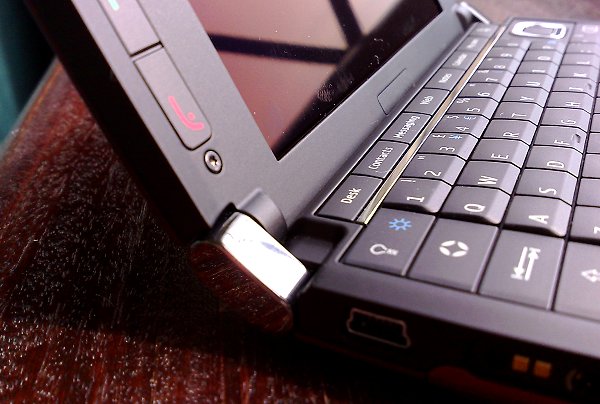
Wait a minute – I hear you say – how can I be delivering a verdict on the Nokia E90 when I haven't really covered all the things it can do yet? In addition, surely it's not even in production yet?
True, true, but I've been using the E90 on and off for the last two months. And this is such a significant device in terms of form factor and appeal that I wanted to get my verdict out first. During the next few weeks I'll be covering all the individual aspects in more detail, including a special 'away with the E90' experiment.
The E90 is undoubtedly a niche device - luckily for Nokia it's a niche that's very well defined and one which already has buyers queueing up for the latest and greatest Communicator. The concept of a laptop-like text entry device which is genuinely phone-sized is still a valid one. The E90 follows a line of similar devices with ever increasing basic specifications but a subtly changing interface, from the original (non-Symbian) 9000 and 9110, to the 9210 and then 9500.
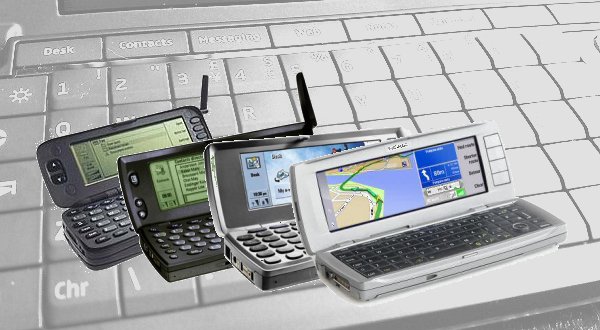
What's compelling about the E90 is that the hardware extras match anything else in the world, even including Nokia's own N95 wonder-phone. Output from the 3 megapixel stills camera is quite superb and arguably as good as anything from the N95, N93 or N73, video recording at VGA and 25fps is smooth and bright and again comparable to the best footage from the N93 and N95, stereo music output over built-in speakers is louder and of higher quality than any other smartphone or communicator (N95 included), and GPS navigation is as good (or maybe that should be as adequate) as on the N95.
All of this on a business-focussed communicator with many optimisations of its own for professionals, i.e. the smallish but usable (this review is being typed on the E90) qwerty keyboard, the huge 800 by 352 pixel display and the many dedicated application keys (for all the core apps, plus profiles and custom application assignments).
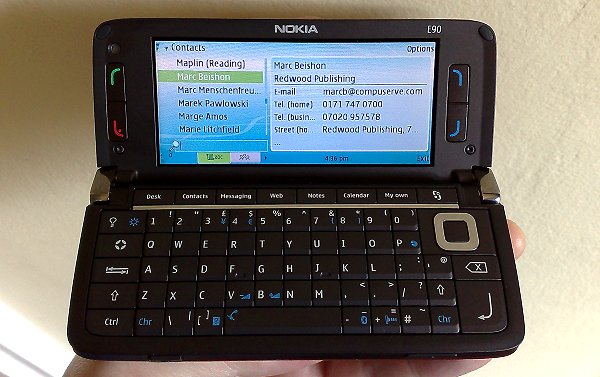
The build quality, even on the prototypes I've looked at, has been exemplary and there's no suggestion of any weaknesses, with a combination metal and plastic body and industrial strength hinges. The E90 exudes confidence and it's a pleasure to pick up and use. The keyboard, seen from the perspective of the old Psions from the late 1990s and also from the larger keyboard on the 9210 and even that on the 9500, is disappointingly small, although in fairness the E90 itself is smaller than any of its flagship predecessors and the increasing miniaturisation by necessity means smaller keys – at least the E90's keyboard is much better than that on the 9300 smartphone. Part of the problem is that the feel of each key is quite hard, but you do get used to it fairly quickly.
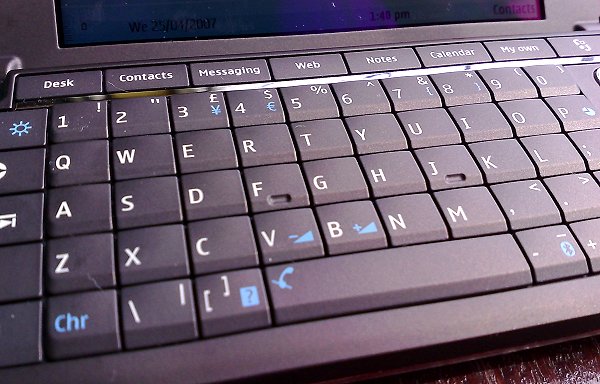
The number one question hanging over the E90 is the switch by Nokia from their Series 80 interface (and associated Psion-derived applications) used on the 9500, to a tweaked version of S60, as seen on (for example) the E61 and E70. S60 (or Series 60 as it started out) was originally designed for a tiny 176 by 208 pixel (portrait) display with input via a numeric keypad and here we have essentially the same interface running on a screen with almost ten times the area, the opposite aspect ratio and a full qwerty keyboard. It's quite a leap.
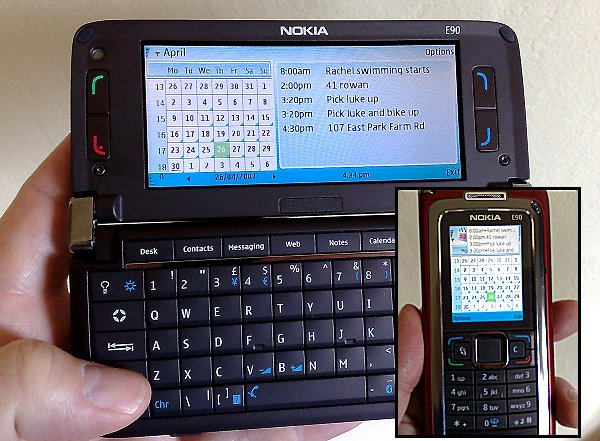
The problem Nokia faced back in 2004 was what to do about its diverging product range. The mass market Series 60 smartphones were taking off in a huge way, while the Series 80-based communicators had a dedicated but smaller market. And changes were afoot behind the scenes, with Symbian OS 8 and then Symbian OS 9, bringing in all the needed changes for 3G/HSDPA compatibility, cutting edge multimedia, single-processor designs and (eventually) dramatic changes in the application/security model. In theory, the Series 80 interface could have been worked on, adapting it to the new OS versions in the same way as Series 60, but I'm guessing even Nokia's pockets aren't limitless and Series 80 never received the necessary resources.
Back in 2007, we have Symbian OS 9 and S60 3rd Edition well established and stable, but Series 80 is now way too far back in the roadmap to continue working with. With the perceived need for a replacement for the 9500 and 9300, and with the qwerty-based E61 and E70 proving surprisingly successful, a S60-based Communicator seemed the way to go. Based on my tests so far, I'd rate the experiment as a success:
- The E90 works superbly as a phone.
- The E90 is a capable email device, with the standard S60 POP3/IMAP4 email support and retrieval, plus support for all push email systems if you want to sell your soul to the 'push' devil and also hammer into your E90's battery life.
- The E90 is a capable document editor and PIM tool, about as good as you'll get on a 'phone' for Office editing and Outlook mobile office organisation (note that the various Windows Mobile touchscreen devices don't really count as 'phones' here).
- The E90 is, amazingly, (in my opinion) as good a stills camera and camcorder as the N95: (click each image to see the original E90 photo)
- The E90 is a splendid music player with all the modern frills and loud stereo speakers (with the caveat that there are no dedicated playback control keys, you have to use the standby screen or the Music player application itself).
- The E90 is the best web browsing tool in the S60 world at the moment, thanks to S60 3rd Edition FP1's version of Web, the presence of a keyboard and the large 800 pixel wide screen. It still falls some way short of the full 2007 Flash-infested experience though, we'll have to wait another year or so for that... (click each screen thumbnail to see it full size)
- The E90 is a good navigation tool, with free street maps and routing wherever you happen to be in the world, all linked to a built-in low power GPS that's well behaved provided you give it a couple of minutes to work out where all the satellites are and which ones to lock onto.
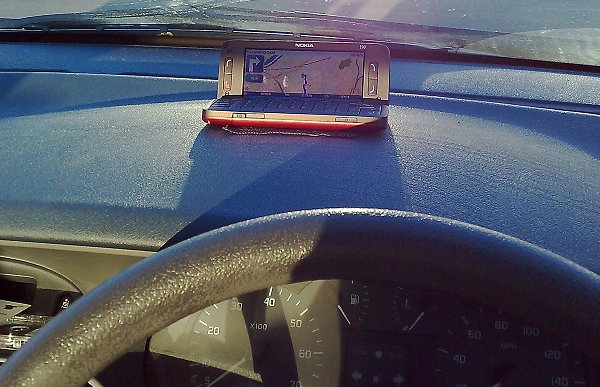
- The E90, by virtue of running S60 3rd Edition, is immediately able to run a fair number of useful third party applications (plus all Java apps, of course). The number is limited now partly because of the necessary restrictions imposed by Platform Security in Symbian OS 9, which has constrained the growth of add-on software, and partly because not every S60 3rd Edition application runs well yet on a FP1 device with a new display size. Still, even gems like Mobipocket Reader, Opera Mini, Handy Safe and Python make the use of S60 worthwhile: (click each screen thumbnail to see it full size)
- The E90, with its 1500mAh battery, has superb longevity and I've happily thrashed it and its camera/GPS/Wi-Fi and managed two days between recharges. Unlike the N95's battery-eating Carl Zeiss camera, the unit in the E90 seems much more frugal.
Add up the attributes above and add in quite a few other features and utilities that I'll be exploring over the next few weeks and you end up with a largely satisfactory and impressive ultra-converged communicator.
So, who are the target market for the E90 and what are they already using now?
Psion palmtop users: Yes, there are still tens of thousands of these, mainly in the UK, hanging onto hardware that's no longer supported and very unreliable, simply because they've never found anything to replace it. Moving from a Psion Series 5mx or Revo, users will notice the following 'cons':
- No touchscreen – probably a blessing, the absence of a touch layer on the E90 (and on most other S60 devices) increases contrast outdoors, though its absence does mean that Sketch-like graphical applications and a number of popular handheld games aren't practical.
- No Data – probably the long lost Symbian application, although hopefully Contacts and the 3rd party HanDBase can replace Data between them....
- A less usable keyboard – a necessary but noticeable downgrade in order to get a much smaller device and with so many other miniaturised features.
On the plus side, the Psion owner can leave their old phone, camera, camcorder, MP3 player and GPS at home (wow, did we really have to worry about so many 'boxes'?).
Existing users of the Nokia communicators (9210/9500/9300): These are still very widespread, of course. Users will notice the following cons:
- Despite the external similarity, the Series 80 interface is no more. S60, it has to be said, doesn't use the screen real estate as well and you can't tab across to the other 'side' in any of the split screen layouts (e.g. Contacts or Calendar). Going from one interface to the other does jar every now and then.
- The multi-card Series 80 menu in each application has been replaced by the single card 'Options' menu, which, although more context-sensitive, has generally fewer functions and real options.
- Only two right-of-screen function buttons (rather than four).
On the plus side, the E90 is smaller than all previous communicators apart from the 9300 and has considerably more functionality, including the aforementioned superb camera, GPS and HSDPA data.
What about those currently making do with an existing Nokia Eseries device, perhaps the E61 or E70, also with qwerty keyboards (albeit smaller)? For them, possible cons are:
- Larger size and weight (obviously)
- Some third party applications won't now work (because of FP1 and the new screen size) and will need an update from developers.
It's mostly gain for existing Eseries owners though, with a better keyboard and bigger screen, more flexibility, an insanely great camera, HSDPA, FP1 improvements and GPS.
The Nokia E90 will also probably appeal to those using keyboarded Windows Mobile devices like the HTC Wizard and TyTN. Cons for them:
- A new interface to learn (no stylus or touchscreen).
- Third party apps from the Windows Mobile world are unlikely to have E90-compatible versions, there's certainly less choice with the latter.
On the plus side, there's a far bigger screen and one with better contrast outdoors, a more phone-like form factor, faster data speeds, built-in GPS and a far, far better stills and video camera.
The Nokia E90 is the single most 'converged' device I've ever seen. And remember that I''ve had plenty of time on the N95...
To have a single device on my belt that's a phone, PDA, keyboarded communicator and mobile office, Internet browser, camera, camcorder, GPS navigator and music player, with no extra accessories or dangly bits, is utterly awesome. From filming my family playing by the river yesterday, I sat down on a bench and replied to email, then used the same device again to voice-navigate us all home, answering a call on hands-free en route.
Over the next few weeks, I'll be looking at specific areas of the Nokia E90's functionality – nothing's perfect and I'll be exploring both the good and bad:
- Nokia E90 as PDA: how well have the S60 PIM applications been adapted to the larger screen and what limitations are there?
- Nokia E90 as mobile office, handling documents, email and the Web.
- Nokia E90 as camera, camcorder and music player.
- Nokia E90 in other roles: as navigator, phone(!), general computer – what else can you do with it?
Steve Litchfield, All About Symbian, 30 April 2007
Reviewed by Steve Litchfield at














